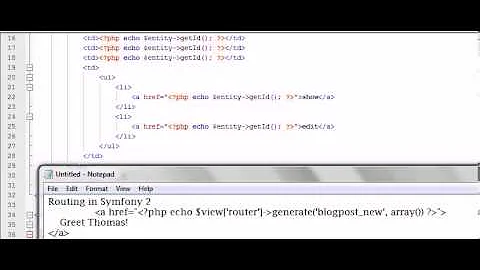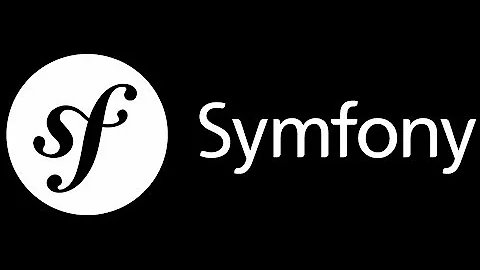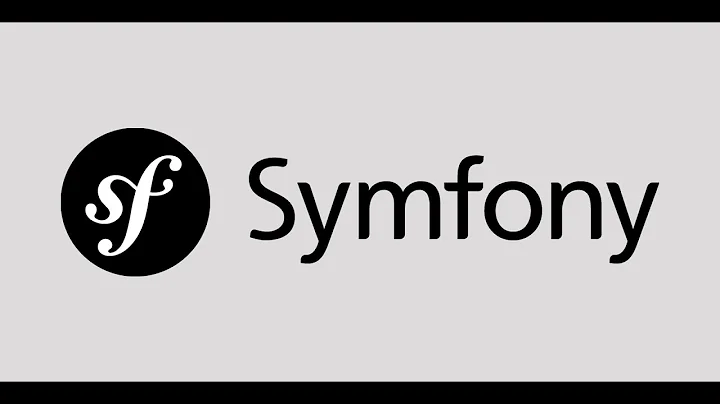Routing in Symfony2
Solution 1
I was looking through the cookbook for an answer to this, and think I've found it here. By default, all route parameters have a hidden requirement that they match any character except the / character ([^/]+), but this behaviour can be overridden with the requirements keyword, by forcing it to match any character.
The following should create a default route that catches all others - and as such, should come last in your routing config, as any following routes will never match. To ensure it matches "/" as well, a default value for the url parameter is included.
default_route:
pattern: /{url}
defaults: { _controller: AcmeBundle:Default:index, url: "index" }
requirements:
url: ".+"
Solution 2
I don't think it's possible with the standard routing component. Take a look to this bundle, it might help : https://github.com/hidenorigoto/DefaultRouteBundle
Solution 3
// Symfony2 PR10
in routing.yml:
default:
pattern: /{_controller}
It enables you to use this kind of urls: http://localhost/MySuperBundle:MyController:myview
Solution 4
Symfony2 standard routing component does not support it, but this bundle fills the gap Symfony1 left:
https://github.com/LeaseWeb/LswDefaultRoutingBundle
It does what you expect. You can default route a bundle using this syntax:
FosUserBundle:
resource: "@FosUserBundle"
prefix: /
type: default
It scans your bundle and automatically adds routes to your router table that you can debug by executing:
app/console router:debug
Example of automatically added default routes:
[router] Current routes
Name Method Pattern
fos_user.user.login_check ANY /user/login_check.{_format}
fos_user.user.logout ANY /user/logout.{_format}
fos_user.user.login ANY /user/login.{_format}
...
You see that it also supports the automatic "format" selection by using a file extension (html, json or xml).
Solution 5
Here is an example: http://docs.symfony-reloaded.org/master/quick_tour/the_big_picture.html#routing
A route definition has only one mandatory parameter pattern and three optionals parameters defaults, requirements and options.
Here's a route from my own project:
video:
pattern: /watch/{id}/{slug}
defaults: { _controller: SiteBundle:Video:watch }
requirements: { id: "\d+", slug: "[\w-]+"
Related videos on Youtube
umpirsky
Updated on July 09, 2022Comments
-
umpirsky almost 2 years
How to setup default routing in Symfony2?
In Symfony1 it looked something like this:
homepage: url: / param: { module: default, action: index } default_symfony: url: /symfony/:action/... param: { module: default } default_index: url: /:module param: { action: index } default: url: /:module/:action/... -
umpirsky about 13 yearsAnother way is to do it with annotations bundles.symfony-reloaded.org/frameworkextrabundle/… Still no default route.
-
 Denis Gorbachev about 13 yearsNo, it's possible. See the answer below.
Denis Gorbachev about 13 yearsNo, it's possible. See the answer below. -
 Eno over 12 yearsI think what's odd, is that if you generate your bundle using the console tools, it creates a default controller with routing defined via annotations. But the official book makes no mention of routing via annotations - there's no mention in the book. If this is the default setup, I would think it should be pointed out and documentation (or links to it) provided.
Eno over 12 yearsI think what's odd, is that if you generate your bundle using the console tools, it creates a default controller with routing defined via annotations. But the official book makes no mention of routing via annotations - there's no mention in the book. If this is the default setup, I would think it should be pointed out and documentation (or links to it) provided. -
Peter O. about 12 yearsBASTA''s comment: "@Marc Morera Merino: consider this use case - a blog with default view, single post view, guestbook, guestbook entry form etc. For the default view, I don't want the URL to be of the form
http://example.com/blog/slug, but simplyhttp://example.com/slug. This will be the default view of the site, and certainly nothing that can be conceived as 'exception'". -
domguinard almost 11 yearsWorked, cheers but just to enhance: "Default" is the classname of your controller (first letter capitalized without the "Controller" part).
-
JamesHalsall over 10 yearsAlso, it is completely reasonable to want to have your JS handle the routing and dynamically load the application view, in this case all routes would serve a base layout and your JS router would determine the URL and render the view. This calls for a catch all route
-
Luke over 10 yearsThere is a problem with the code presented in this answer, it needs a route name. Currently
pattern:is assumed to be the route name andpattern:,defaults:andrequirements:need to indented at the same level. -
h00ligan over 9 yearsMarc, I guess you haven't heard about SEO, changing routes is sometimes necessary when restructuring a site and a catch-all may be needed to be able to give a correct redirect (301 Status)
-
Longsight almost 8 yearsThanks, that was probably a rush copy/paste job from my routes file!





![Symfony Routing Tutorial - Controller, Annotations, Param Conversion + more [Symfony Workshop 2020]](https://i.ytimg.com/vi/oFddUtFNkCs/hq720.jpg?sqp=-oaymwEcCNAFEJQDSFXyq4qpAw4IARUAAIhCGAFwAcABBg==&rs=AOn4CLCcYpJaa78zBlAer_cwB3BiL11IlA)

